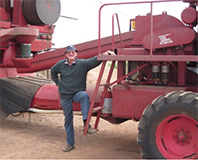Read the latest information on
Foot-and-mouth disease

Dr Mike Walsh and Peter Newman take you through all you need to know about managing weeds at harvest time
The results of the 2017 Farm Biosecurity Survey showed that producers spend a lot of time controlling weeds, so here’s something that might appeal to you.
While it may be a bit late for this season’s harvest, now’s the perfect time to do your research and add some new actions to your plan to implement biosecurity measures on your farm next year.
In a new online course, WeedSmart experts Dr Mike Walsh and Peter Newman take you through all you need to know about managing weeds at harvest time.
This is their second online course (the first one being on herbicide resistance), this time they are covering the science of harvest weed control, the nutrient implications, and the costs of all the different tools.
They run through six different harvest weed control tools, talking about the pros and cons of each and where they fit in the farming system. The modules are:
You can watch an introductory video to see if it’s for you before signing up for the free course. All up, it takes about two hours, but you can do it at your own pace and spread it out over a couple of weeks if that suits you better.

Ray Harrington developed ‘the Destructor’ that smashes the chaff and weed seeds as they leave the harvester, destroying seed viability and returning the crushed fraction to the paddock.
After signing up, you’ll get access to the course (with nine videos) that covers the basics of harvest weed seed control, plus practical tips to help you incorporate these systems on your farm.
There’s videos, pdf downloads, and simple quizzes to help you get the most out of the Harvest Weed Seed Control 101 course, but you choose your own level of involvement.